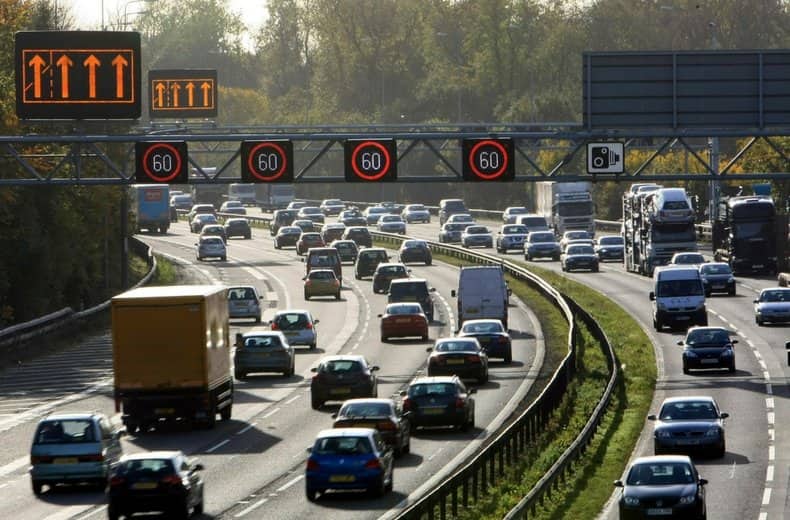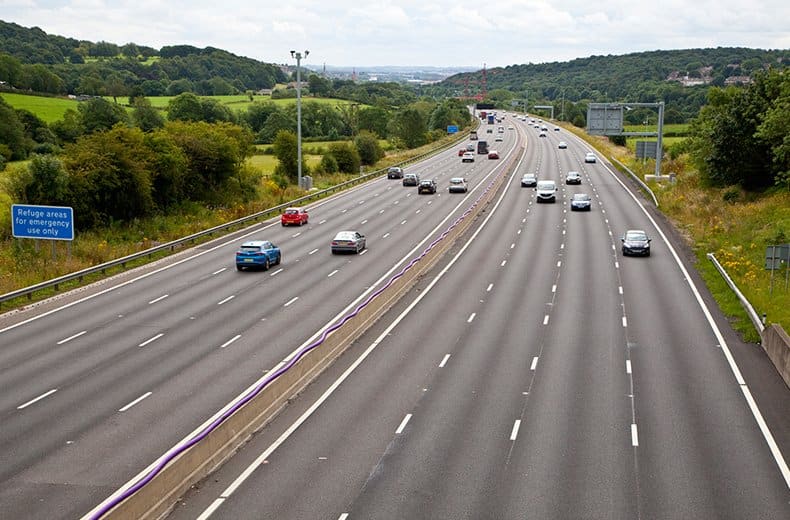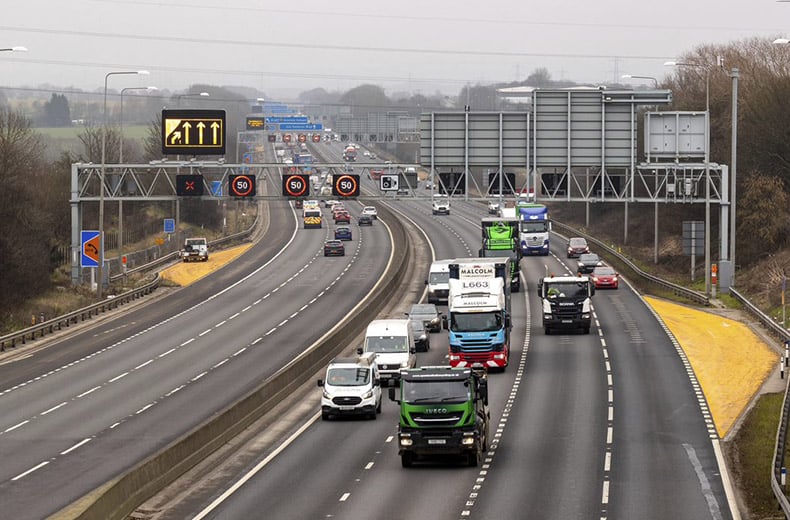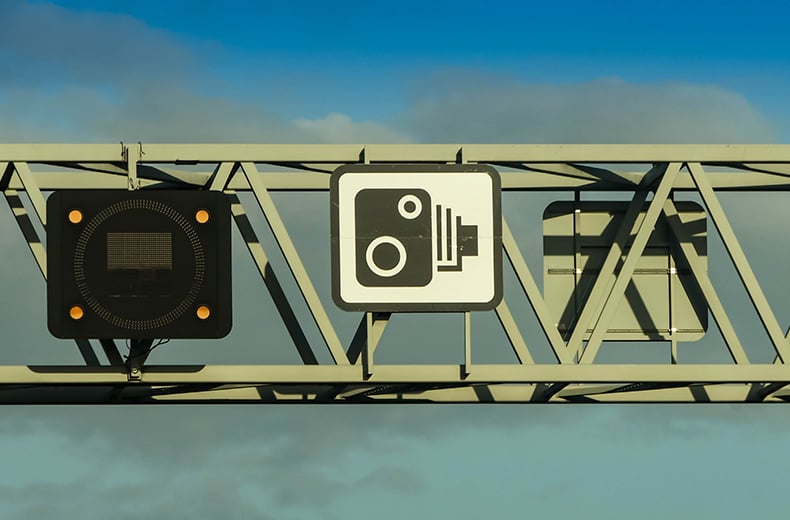However, while some motorists continue to question if this is the end for smart motorways in the UK, there are still many miles of smart motorway already in place across the country, so it's vital drivers and riders get to grips with how to use them.
Understandably, drivers have a lot of questions about these newer types of motorway: what are they, how do I use them, what do I do if I break down on them, are they more dangerous, and what fines can I get while using a smart motorway?
Here we have endeavoured to answer many of these with the latest RAC driving advice to help motorists have a smoother and safer driving experience.
What is a smart motorway?
A smart motorway is a section of a motorway that uses traffic management methods to increase capacity and reduce congestion in particularly busy areas.
These methods include using the hard shoulder as a running lane and using variable speed limits to control the flow of traffic.
National Highways developed smart motorways to manage traffic in a way that minimises environmental impact, cost and time to construct by avoiding the need to build additional lanes.
There are three types of scheme which are classed as smart motorways.

Cheaper than AA or we’ll beat by 20%^
• Roadside cover from £5.49 a month*
• We get to most breakdowns in 60 mins or less
• Our patrols fix 4/5 breakdowns on the spot

What different types of smart motorway are there?

The three different types of smart motorway currently include: controlled motorways, dynamic hard shoulder running schemes and all lane running schemes.
'All lane running' schemes
As the name suggests, ‘all lane running’ schemes permanently remove the hard shoulder and convert it into a running lane.
On these types of motorway, lane one (formerly the hard shoulder) is only closed to traffic in the event of an incident.
In this case, a closure of one or more lanes will be signalled by a red X on an overhead gantry and/or on a verge-mounted sign, meaning you must exit the lane/s as soon as possible.
Ignoring the ‘red X’ sign is extremely dangerous and illegal.
Signage is also used to display the mandatory speed limit which varies depending on the traffic conditions. If no speed limit is displayed the national speed limit is in place. Speed cameras are used to enforce these.
Drivers have voiced concerns about sudden variable speed limit changes causing them to slam on their brakes to reduce their speed in time.
Highways England has clarified there is a slight lag between when the speed limit is changed and when the cameras will begin to enforce that speed limit, to accommodate drivers reducing their speed at a sensible rate.
A specific time period is not given for every camera, however, and it can be as quick as ten seconds, so it is crucial drivers remain alert and respond to variable speed limits swiftly and safely.
CCTV is used to monitor traffic for any incidents. Should drivers break down or be involved in an accident there are emergency refuge areas (ERAs) at the side of the carriageway for them to use.
These are typically further apart than current sections of ‘dynamic hard shoulder’ smart motorway, with an average spacing of 1.5 miles apart, however, the RAC is urging Highways England to retrofit more ERAs, closer together on ‘all lane running’ sections. The RAC also wants radar technology fitted to all stretches of smart motorway to ensure stricken vehicles in live lanes are detected as quickly as possible.
'Dynamic hard shoulder' schemes
‘Dynamic hard shoulder’ running involves opening the hard shoulder as a running lane to traffic at busy periods to ease congestion.
On these stretches a solid white line differentiates the hard shoulder from the normal carriageway. Overhead signs on gantries indicate whether the hard shoulder is open to traffic.
The hard shoulder must not be used if the signs over it are blank or display a red X, except in the case of an emergency. Other variable message signs will say ‘hard shoulder for emergency use only’.
A red X on the gantry above means you must exit the lane as soon as possible.
Ignoring the ‘red X’ sign is extremely dangerous and illegal.
Overhead gantries on these types of motorway also display the mandatory speed limit which varies depending on the traffic conditions. Speed cameras are used to enforce these - no speed limit displayed indicates the national speed limit is in place.
Drivers have voiced concerns about sudden variable speed limit changes causing them to slam on their brakes to reduce their speed in time.
Highways England has clarified there is a slight lag between when the speed limit is changed and when the cameras will begin to enforce that speed limit, to accommodate drivers reducing their speed at a sensible rate.
A specific time period is not given for every camera, however, and it can be as quick as 10 seconds so it is crucial drivers remain alert and respond to variable speed limits swiftly and safely.
CCTV is used to monitor traffic for any incidents. Should drivers break down or be involved in an accident there are emergency refuge areas at the side of the carriageway for them to use.
'Controlled motorway' schemes
Controlled motorways have three or more lanes with variable speed limits, but retain a traditional hard shoulder. The hard shoulder should only be used in a genuine emergency.
These variable speed limits are displayed on overhead gantry signs - if no speed limit is displayed the national speed limit is in place. Speed cameras are used to enforce these.
Drivers have voiced concerns about sudden variable speed limit changes causing them to slam on their brakes to reduce their speed in time.
Highways England has clarified there is a slight lag between when the speed limit is changed and when the cameras will begin to enforce that speed limit, to accommodate drivers reducing their speed at a sensible rate.
A specific time period is not given for every camera, however, and it can be as quick as 10 seconds so it is crucial drivers remain alert and respond to variable speed limits swiftly and safely.
Are smart motorways dangerous?
Many people are of the opinion that smart motorways are more dangerous than conventional motorways, because of the lack of a hard shoulder. Seven-in-10 drivers (69%) want the hard shoulder to be reinstated on smart motorways, regardless of the Government claiming it would be too disruptive and costly, according to research by the RAC.
National Highways has published statistics from data gathered since the first smart motorway opened in 2006 to claim:
- Journey reliability has improved by 22%
- Personal injury accidents have been reduced by more than half
National Highways has run communication campaigns to educate drivers how to use smart motorways, including the importance of always obeying red X signs. Increasingly, Emergency Refuge Areas (ERAs) are also painted in orange to help drivers spot them, and there are more signs directing drivers to their next ERA.
But the RAC continues to argue for more changes to be made to smart motorways to make them as safe as possible, and to help ensure drivers feel safe when driving on them - especially on stretches of 'all lane running' smart motorway where the hard shoulder is removed for good.
What are the rules on a smart motorway?
Of course, all normal road rules and laws apply on smart motorways but there are a few points in particular that are worth clarifying.
Smart motorway speeding
The same laws and sentencing applies for speeding on a smart motorway, but with more cameras on smart motorways and variable speed limits, motorists typically have a much higher chance of getting caught and fined for speeding.
This is further fuelled by the fact that many drivers do not realise cameras on smart motorways that enforce variable speed limits can still catch you travelling over the national speed limit, when a variable limit isn't in place.
National Highways has stated that: "If no special speed limit is displayed then the national speed limit applies. Speed cameras are in operation on smart motorways. If you don’t keep to the speed limit, you may receive a fine."
Given the new speeding sentencing structures that could lead to as much as a £2,500 fine for offenders, motorists who flout the rules leave themselves wide open to a more severe punishment.
Red X fines
Ignoring the ‘red X’ sign is extremely dangerous.
Camera enforcement can see drivers face an automatic £100 fine and three penalty points for doing so.
Where will I see the red cross (X) symbol?
The red X is an increasingly common sight on the UK's roads, especially the latest generation of smart motorways where traffic is managed and lanes controlled. You'll find it either on an overhead gantry, or increasingly on cantilever signs at the side of the road.
What does the red X mean?
Regardless of where you see the sign, either on a normal traffic lane or on a hard shoulder on a motorway hard shoulder, it simply means do not drive in the lane - it has been closed to traffic.
Why is the red X important?
While motorways are statistically the safest type of road in Britain they can be dangerous for everyone at the scene of a breakdown. This risks involved in a motorway breakdown mostly concern the high speed of the passing traffic, but with more so-called ’smart’ motorways without a permanent hard shoulder being introduced all the time, the risks of an incident occurring are potentially far greater.
When the relevant highways traffic management authority becomes aware of a breakdown or incident on a smart motorway they switch on a ‘red cross’ sign on the gantries that span the carriageway to close the lane to traffic.
Ignoring the ‘red X’ sign is an offence as it is extremely dangerous to so, potentially causing serious injury to those at the scene, as well as the occupants of the offending vehicle. Any driver who ignores the red cross sign could be fined £60 and receive three penalty points on their driving licence.
- Fixed Penalty Notices: all you need to know
- Traffic light cameras: what you need to know
- Dangerous driving - what it is and how to report it
Tips for driving on smart motorways

- Never drive in a lane closed by a 'red X'
- Keep to the speed limit shown on the gantries
- A solid white line indicates the hard shoulder - never drive in it unless directed
- A broken white line indicates a normal running lane
- If your vehicle experiences difficulties, e.g. a warning light, exit the smart motorway immediately if possible and find a place of relative safety to stop
What is an Emergency Refuge Area (ERA) on a smart motorway?

Image: National Highways
Emergency refuge areas (ERAs), or SOS areas, are located on smart motorways and designed to offer a place of relative safety for stranded vehicles on roads without hard shoulders.
Painted orange for improved visibility, they appear up to every 1.5 miles on ‘all lane running’ smart motorways.
RAC research shows that one in four drivers with experience of driving on smart motorways are unaware of ERAs. One in five drivers that broke down on a smart motorway were unaware they should contact National Highways when using an ERA.
If you’ve broken down or have been involved in an accident while on a smart motorway, you should attempt to use an emergency refuge area.
These are marked with large blue signs featuring an orange SOS telephone symbol.
Arrows will direct you into an indicated area marked on the tarmac and painted orange, where you should stop and switch on your hazard warning lights.
Occupants should then exit the vehicle from the passenger side and stand behind the crash barrier.
The SOS telephone should be used to speak to a representative at National Highways who will provide further instructions.
You should only use an emergency refuge area in the event of a breakdown or an accident. They are not be used for a rest stop, to make a phone call or to use the toilet.
- Motorway cameras – what you need to know
- The real causes of motorway traffic and how to stop it
- Learner drivers on motorways – everything you need to know
I've broken down on a smart motorway - what should I do?
If you are unlucky enough to break down or be involved in an accident while on a smart motorway, you should follow these steps:
- Use an emergency refuge area (ERA) if you are able to reach one safely.
If you are unable to reach the nearest ERA or exit your vehicle safely follow these steps:
If you cannot get to an emergency refuge area, you should try to move on to the verge if there is no safety barrier and it is safe to do so
In all cases, switch on your hazard warning lights
If you stop in the nearside lane, exit your vehicle via the nearside (left hand) door if it is safe to do so and wait behind the safety barrier, if there is one
If it is not possible to get to the nearside lane or exit your vehicle safely, then you should stay in your vehicle with your seat belt on and dial '999' if you have access to a mobile phone
When the relevant highways authority becomes aware of a breakdown or an incident on a smart motorway they should switch on a ‘red cross' sign on the gantries above the lane you're in to stop traffic from entering it- If you cannot get to an emergency refuge area, you should try to move on to the verge if there is no safety barrier and it is safe to do so
- In all cases, switch on your hazard warning lights
- If you stop in the nearside lane, leave your vehicle via the nearside (left hand) door if it is safe to do so and wait behind the safety barrier, if there is one. Then contact National Highways via the roadside emergency telephone provided in all emergency refuge areas
- If you are unable to move over to the nearside lane or if it is not possible to get out of your vehicle safely, then you should stay in your vehicle with your seat belt on and dial '999'
- For advice on what to do if you break down elsewhere you might also want to refer to our general motorway breakdown advice
Does the RAC attend breakdowns on smart motorways?
Yes, but as all lanes of most smart motorways are used for traffic, either all or some of the time, the RAC has to work closely with National Highways for safety reasons in order to attend members who break down on them.
Drivers who break down and successfully reach emergency SOS refuge areas, which are currently spaced up to 1.5 miles apart, can be attended without any initial involvement from National Highways.
However, for drivers who break down in a live running lane the RAC can only attend once National Highways has made the scene as safe as possible through the closure of lanes with the red X signs and the attendance of National Highways Traffic Officers or police officers to provide protection for both our patrols and customers.
Which motorways are smart motorways, and where will new ones be?
The smart motorway network covers around 300 miles. .
There are three different types of smart motorway in the UK. You can find smart motorways at the following places:
| All lane running | Dynamic hard shoulder | Controlled motorway | |
| M1 | J16 to J13 J19 to J16 J24 to J25 J28 to J31 J32 to J35a J39 to J42 | J10 to J13 | J6a to J10 J23a to 24 J25 to J28 J31 to J32 |
| M3 | J2 to 4a | ||
| M4 | J3 to J12 | J19 to J20 | |
| M5 | J4 to J6 | J15 to J17 | |
| M6 | J2 to J4 J10a to J13 J13 to J15 J16 to J19 | J4 to J10a | J10a to J11a |
| M20 | J3 to J5 | J4 to J7 | |
| M25 | J5 to J6/7 J23 to J27 | J2 to J3 J7 to J23 | |
| M23 | J8 to J10 | ||
| M27 | J4 to J11 | ||
| M42 | J7 to J9 | ||
| M60 | J8 to J18 | ||
| M62 | J10 to J12 J18 to J20 J25 to J26 | J23 to J30 | J28 to J29 |
Where are smart motorway cameras located?

Smart motorway cameras enforce variable speed limits and monitor traffic levels from gantries on England’s roads.
With more cameras on smart motorways, motorists typically have a much higher chance of getting caught and fined for speeding.
Smart motorway cameras are painted yellow and smaller than traditional speed cameras, they can be found either mounted on gantries over the road or on poles at the side of the road.
National Highways’ advice is to treat cameras as though they are always on. When smart motorway cameras haven’t been set to a variable speed limit, they will default to the national speed limit setting.
Cameras on smart motorways that enforce variable speed limits can still catch you travelling over the national speed limit even when a variable limit isn't in place.
Smart motorway cameras are set to the national speed limit by default but change according to the variable speed limit. There is a slight lag between when the speed limit is changed and when the cameras will begin to enforce that speed limit. This is to allow for drivers reducing their speed at a sensible rate. This lag can be as quick as 10 seconds.
How do smart motorways detect a stationary vehicle?
Stationary vehicles are detected on smart motorways through CCTV cameras and technology through a system called MIDAS, which picks up slowing traffic because of an incident.
More intelligent radar technology known as ‘stationary vehicle detection’ (SVD) is used on all stretches of ‘all lane running’ smart motorways, which automatically picks up a stranded vehicle. The technology can detect stationary vehicles up to 16 minutes quicker than a camera-based system.
The performance of the SVD system was independent assessed by the Office of Road and Rail, in its second Annual Assessment of Safety Performance on the Strategic Road Network in 2023.
“Our technology is part of a solution that has been independently verified to meet or exceed all design criteria, detecting ~90% of stopped vehicles within 20 seconds. This technology makes any road where it is in place, safer,” said the manufacturer, Navtech Radar.
What is the RAC's opinion of smart motorways?
The RAC has consistently raised the issue of smart motorway safety for many years through the media and through direct engagement with politicians and Government.
We have consistently called for urgent changes to be made to reduce risks related to breaking down on these motorways and have fed in our recommendations to Ministers and policy makers.
We continue to engage at a high level to ensure the changes outlined in the evidence stocktake are implemented but also for more to be done to improve safety.
Smart motorways - frequently asked questions
- What are the benefits of smart motorways?
Smart motorway technology allows Highways England to:
- monitor traffic levels
- change the speed limit to smooth traffic flow, reducing stop-start driving
- alert drivers to hazards and traffic jams ahead
- close lanes to allow vehicles to attend an emergency
Smart motorways increase road capacity at a much smaller cost than traditional road-widening schemes, with minimal environmental impact. Drivers benefit from shorter journey times and safer travelling conditions.
- Who is responsible for smart motorways?
Smart motorways are a Highways England initiative to add 4,000 miles of extra capacity to England’s roads. Motorway and major road network congestion in England costs an estimated £2 billion every year.
- Do smart motorways have speed cameras?
Smart motorways feature more speed cameras than traditional motorways to monitor variable speed limits. Cameras can still catch you travelling over the national speed limit even when a variable limit isn’t in place.
- Do smart motorway speed cameras flash?
Smart motorway cameras do not use a visible flash. A unit next to the cameras gives an infra-red flash that allows the camera to operate at night and in low light conditions.
- What do smart motorway cameras look like?
Smart motorway cameras are painted yellow and smaller than traditional speed cameras, they can be found either mounted on gantries over the road or on poles at the side of the road.
- Are smart motorway cameras always on?
Highways England’s advice is to treat cameras as though they are always on. When smart motorway cameras haven’t been set to a variable speed limit, they will default to the national speed limit setting.
Cameras on smart motorways that enforce variable speed limits can still catch you travelling over the national speed limit even when a variable limit isn’t in place.
- What speed are smart motorway cameras set to?
Smart motorway cameras are set to the national speed limit by default but change according to the variable speed limit. There is a slight lag between when the speed limit is changed and when the cameras will begin to enforce that speed limit. This is to allow for drivers reducing their speed at a sensible rate. This lag can be as quick as 10 seconds.
5 Star Defaqto rated cover
RAC Comprehensive Car Insurance Plus has been given a 5 Star Rating by Defaqto. Get a quote online today.


Services we offer
- Breakdown Cover
- European Breakdown Cover
- Motorbike Breakdown Cover
- Electric Car Breakdown Cover
- Caravan, Motorhome and Campervan Breakdown Cover
- Business Breakdown Cover
- Van Breakdown Cover
- RAC Approved Garages
- Vehicle servicing
- Vehicle repair
- MOTs
- Mobile mechanics
- RAC Tyres
- RAC Approved Dealers
- RAC Shop
- myRAC app









